
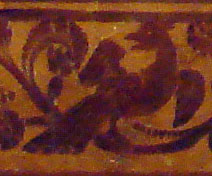 This is the debut exhibition of The Gonzaga Collection: Rare Books from the Jesuit Oregon Province, the University's choice collection of over three thousand volumes of rare books and manuscripts in philosophy, theology, literature and art. Previously these books had been at three Jesuit scholasticates: that outside Spokane and the ones in Port Townsend, Washington, and in Sheridan, Oregon. (To go to information on all other rare books at Gonzaga, click here.)
This is the debut exhibition of The Gonzaga Collection: Rare Books from the Jesuit Oregon Province, the University's choice collection of over three thousand volumes of rare books and manuscripts in philosophy, theology, literature and art. Previously these books had been at three Jesuit scholasticates: that outside Spokane and the ones in Port Townsend, Washington, and in Sheridan, Oregon. (To go to information on all other rare books at Gonzaga, click here.)
 Because books had come to those schools from Jesuit institutions throughout the region, The Gonzaga Collection offers a glimpse into the humanistic tradition in action in Jesuit formation and missionary work.
Because books had come to those schools from Jesuit institutions throughout the region, The Gonzaga Collection offers a glimpse into the humanistic tradition in action in Jesuit formation and missionary work.
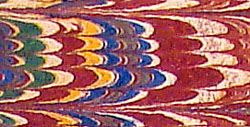 Significant private donations to the scholasticates and a major influx of rare books to one in 1930 mean that The Gonzaga Collection also contains several striking and even unique works.
Significant private donations to the scholasticates and a major influx of rare books to one in 1930 mean that The Gonzaga Collection also contains several striking and even unique works.
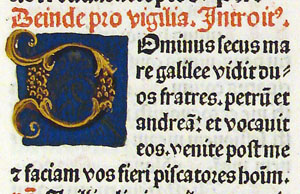 To protect these fragile volumes from light, each month a different page of each book will be displayed in the Cowles Rare Book Library (this online exhibition can of course keep all images available the whole time). The detail to the right, for instance, is from a volume printed in red and black ink in 1484 and hand-illuminated in that year. The colors are still vivid after more than six centuries, and prudent care of this book will keep it that way.
To protect these fragile volumes from light, each month a different page of each book will be displayed in the Cowles Rare Book Library (this online exhibition can of course keep all images available the whole time). The detail to the right, for instance, is from a volume printed in red and black ink in 1484 and hand-illuminated in that year. The colors are still vivid after more than six centuries, and prudent care of this book will keep it that way.
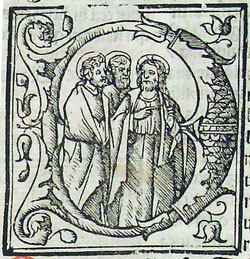

Humanistic study was so deeply a part of Jesuit formation and development that even the Jesuit missionaries to the territory of Alaska took with them this volume on justice and the other cardinal virtues, written by a Jesuit and published in 1621. Rubens designed the title page, which records the fact: "Pet. Paul. Rubenius inuent. Cor Galleus Sculpsit" ("Peter Paul Rubens designed [this], Cornelius Galleus engraved [it].") The book stamp at the bottom of the title page shows that this volume was part of the library at the Alaska Mission.
Leonardius Lessius, S.J., De Iustitia et iure ceterisque virtutibus cardinalibus. Libri quatuor, Ad. 2.2 D. Thomae a quaest. 47 usque ad q. 171. Editio quinta, auctior et castigatior; cum appendice de Monte Pietatis. Antuerpiae, Ex Officina Plantinainan, Apud Balthaserem Moretum et Viduam Io. Moreti, et Io Mursium, 1621. (Inv. L84)
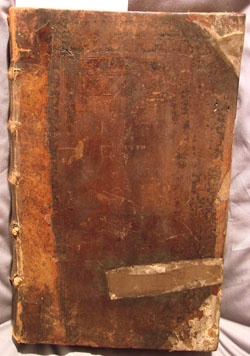
On the front cover, damage from wear exposes the board which forms the basis of the cover and this allows one to see how books were constructed.
Cornelis Cornelissen van den Steen (1567-1637) -- in Latin, Cornelius Cornelii Lapide -- was a Flemish Jesuit and prolific exegete, commenting on every biblical book except Job and Psalms. He was also Professor of Holy Scripture and of Hebrew, first at Louvain, then at the Gregorianum in Rome. His works exemplify the practice of considering all available evidence for establishing and analyzing the biblical text, and then interpreting its allegorical, tropological, and anagogical meanings; that is, its symbolic, moral and prophetic meanings. Pages 352-353 of his commentary on Proverbs refer to Hebrew, Chaldean, Greek, Latin and contemporary references, characteristic of this author and this genre. The commentary on the four major prophets displayed here was at a Jesuit institution in Paris. The Rocky Mountain Mission had several volumes by him.

Cornelius Cornelii Lapide, S.J. Commentarius in Salomonis Proverbia. Venetiis: typis, ac noviter sumptibus Hieronymi Albritii, 1717. (SPEC COLL OVRSZ BS 1465 L36 1717)
To see the style of commentary, with its references to various biblical languages and commentators, click as directed below for enlarged PDFs of pp. 352-353.
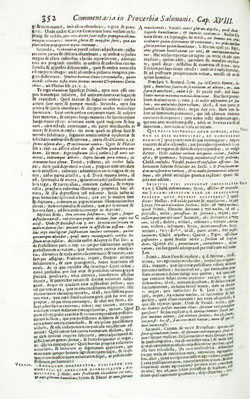

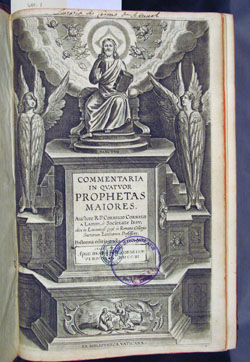 Cornelius Cornelii Lapide, S.J. Commentaria in quatuor prophetas majores, Antverpiae: apud Henrici Verdussen, 1703 (SPEC COLL OVERSZ BS 1505.3.136 1703 c.2 v. 1-2)
Cornelius Cornelii Lapide, S.J. Commentaria in quatuor prophetas majores, Antverpiae: apud Henrici Verdussen, 1703 (SPEC COLL OVERSZ BS 1505.3.136 1703 c.2 v. 1-2)
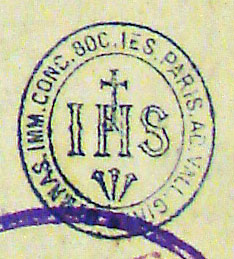 In volume two of this edition of the commentary on the prophets is found this book stamp from a Jesuit foundation in Paris. Note the central IHS. This was the abbreviation for the holy name of IHesuS. The Jesuits adapted this as a monogram for their Society, adding the cross above the letter H and the three nails of the crucifixion below: two nails for Jesus' hands and one for his overlapped feet. (For an elaborate version of this central design, see the 1717 NEEDS UPDATED LINK tailpiece at the end of this online exhibition.)
In volume two of this edition of the commentary on the prophets is found this book stamp from a Jesuit foundation in Paris. Note the central IHS. This was the abbreviation for the holy name of IHesuS. The Jesuits adapted this as a monogram for their Society, adding the cross above the letter H and the three nails of the crucifixion below: two nails for Jesus' hands and one for his overlapped feet. (For an elaborate version of this central design, see the 1717 NEEDS UPDATED LINK tailpiece at the end of this online exhibition.)
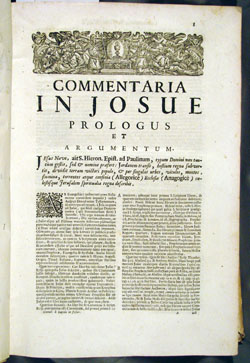
Each commentary in the volume shown to the right has its own title page and decorated first page of text.
Cornelius Cornelii Lapide, S.J. Commentarius in Josue, Judicum, Ruth, quatuor libros Regum, et duos Paralipomenon. Venetiis: typis ac noviter sumptibus Hieronymi Albritii, 1717. (SPEC COLL OVRSZ BS 1205.L36 1717)
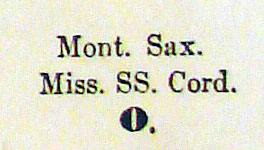
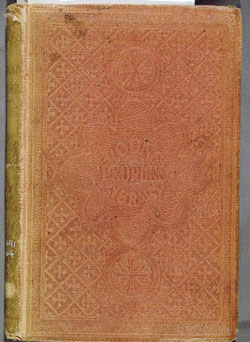
The Catholic and Jesuit understanding that learning and art are to serve pastorally is seen in a volume by Father De Smet, for whom Gonzaga University's De Smet residence hall is named. The embossed cover identifies the work as part of the series, Young People's Library.
Pierre-Jean de Smet, S.J., New Indian Sketches, New York: D. & J. Sadlier [18--?]. (SPEC COLL E77.S64 1800z)
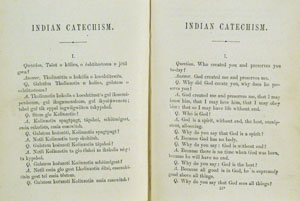 The missionary priests put their linguistic training to practical use in translating the catechism into Kootenai, so that the Native Americans of the region could learn about God in their own language.
The missionary priests put their linguistic training to practical use in translating the catechism into Kootenai, so that the Native Americans of the region could learn about God in their own language.
 Louise Sighouin, daughter of the chief of the Coeur d'Alene Indians, became a devout Christian, ministering to her people, and Fr. De Smet recorded a reverent account of her life in this volume. Another Jesuit priest, Fr. Point, made drawings of her baptism and her grave. These were made into engravings to illustrate this volume. The frontispiece shows her baptism.
Louise Sighouin, daughter of the chief of the Coeur d'Alene Indians, became a devout Christian, ministering to her people, and Fr. De Smet recorded a reverent account of her life in this volume. Another Jesuit priest, Fr. Point, made drawings of her baptism and her grave. These were made into engravings to illustrate this volume. The frontispiece shows her baptism.
 The title page of this volume bears four Jesuit book stamps, three from the St. Ignatius Mission in Montana and then the large round stamp of a scholasticate library of the Oregon Province.
The title page of this volume bears four Jesuit book stamps, three from the St. Ignatius Mission in Montana and then the large round stamp of a scholasticate library of the Oregon Province.
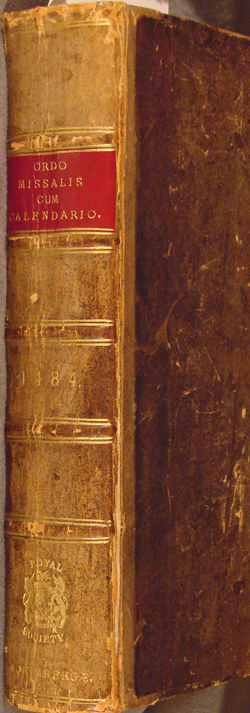
The 1484 Roman Missal in The Gonzaga Collection is an incunabulum, a book from the earliest days of printing (before 1500). Only two other copies of this volume are known to survive, one in the Vatican. The text is pre-Tridentine, that is, the mass as it was celebrated before the Council of Trent. The provenance (history of ownership) of this volume is also of interest. This book was presented to Mount St. Michael's Library on May 6, 1962 by Mrs. Charlotte Sanderson, the widow of Dr. Steven Sanderson. It is now part of The Gonzaga Collection.
The Gonzaga Collection also contains five other Roman Missals, one from 1577 shortly after the Council of Trent; a Mozarabic Missal; and the Dominican Missal shown below.
Missale Romanum. Nuremberg: Georg Stuchs, 1484 (SPEC COLL BX2015.A2 1484)
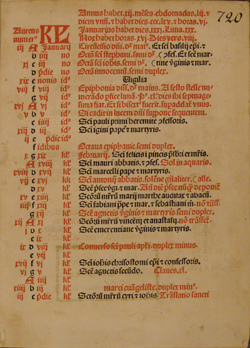 This handsome volume was printed in black and red inks. Liturgical manuscripts and printed books which use red (ruber) ink to mark important feasts are called "rubricated." Seen here is the opening of the calendar.
This handsome volume was printed in black and red inks. Liturgical manuscripts and printed books which use red (ruber) ink to mark important feasts are called "rubricated." Seen here is the opening of the calendar.
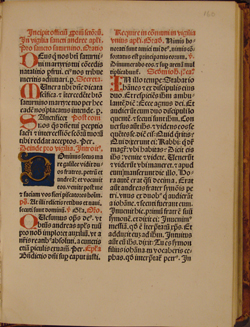
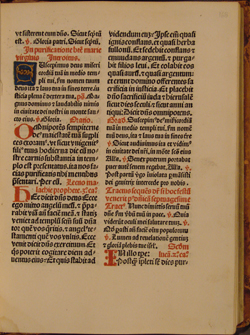
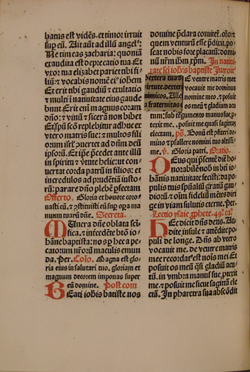
Several of the large initials in this missal were hand-illuminated in blue and gold. To do this, the printer would leave a blank area in the printed page where the initial belonged, and then the artist would paint the initial. The initial "D" is seen on folio 160; the initial "S" on folio 168. Sadly, a modern vandal excised some of these initials, as is evident on folio 179.

The only known copy of this edition appears to be the one in The Gonzaga Collection. In superb condition, this elegant boxed volume is adorned outwardly with skillful, colored marbling on the slipcase, the covers, and the endpapers. Gilt decoration and lettering are found on the spine.
Missale predicator[um] nuper impressum ac emendatum cum multis missis orationibus: pulcherrimisq[ue] capite missarum festivitatum sel[n]nium de novo superadditis... Venice, Giunta, 1521 (Inv. M56)

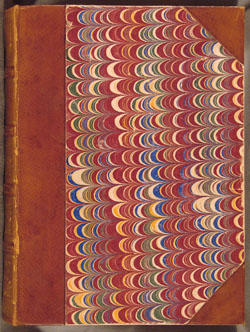

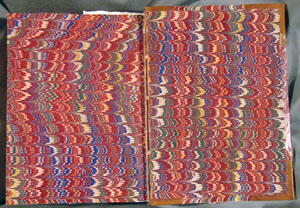
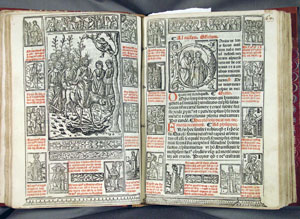 Inside the book, the text is rubricated, as seen on the title page directly above. "Most beautiful pictures" (pulcherrimis figuris) in the form of woodcuts appear at the head of feasts, such as Palm Sunday (fols. 63v-64).
Inside the book, the text is rubricated, as seen on the title page directly above. "Most beautiful pictures" (pulcherrimis figuris) in the form of woodcuts appear at the head of feasts, such as Palm Sunday (fols. 63v-64).
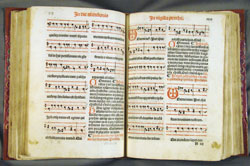 Gregorian chant in the style used by the Dominicans is recorded in this volume. An example is that for Easter on folio 99. This lovely book was evidently another gift from Dr. Steven Sanderson or his widow, for his book plate appears on the front endpaper.
Gregorian chant in the style used by the Dominicans is recorded in this volume. An example is that for Easter on folio 99. This lovely book was evidently another gift from Dr. Steven Sanderson or his widow, for his book plate appears on the front endpaper.
Portions of the Bible had been translated into English since the tenth century, notably the Wessex Gospels (ca. 990) and Ælfric's Heptateuch about the same time. The first Catholic English translation of the entire Bible was the famous Douai Rheims version. The Gonzaga Collection includes a first edition of all three volumes. A sign of how fully Catholicism was under siege in England is that this three-volume Bible had to be published in France. The New Testament was published first, at Rheims, in 1582, and then the Old Testament followed in two volumes, at Douai in 1609-1610. Its pastoral purpose was to present the Catholic interpretation of scripture, and to that end it features extensive notes: At the start of each biblical book is its "argument" (a summary of its contents), each chapter has a headnote, marginal notes occur throughout, and at the end of each chapter are notes. Decorations in this Bible include headpieces at the start of individual biblical books, large illustrated initials at the start of books, two-line high initials at the start of chapters, and tailpieces at the ends of individual books.
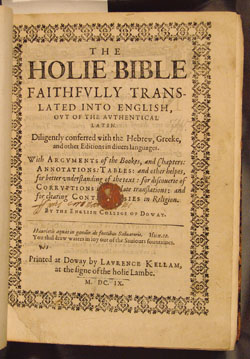
The Holie Bible faithfully translated into English, out of the authentical Latin: Diligently conferred with the Hebrew, Greeke, and other editions in divers languages. With Arguments of the bookes, and chapters, annotations, tables, and other helpes, for better understanding of the text, for discoverie of corruptions in some late translations, and for clearing controversies in religion / By the English College of Doway... 2 vols. Doway [Douai, France]: Printed ... by Laurence Kellam, at the signe of the holy lamb, 1609-1610 (SPEC COLL BS180.1609)
 Clear distinction is made between the biblical text and the commentary on it, by means of type style and layout. Only a narrow headpiece is atop the page with the "argument" of the book of Exodus, while in contrast a substantial decorative band tops the page where the scripture itself begins (pp. 154-155, shown at left). Also, a large decorative initial begins the biblical text.
Clear distinction is made between the biblical text and the commentary on it, by means of type style and layout. Only a narrow headpiece is atop the page with the "argument" of the book of Exodus, while in contrast a substantial decorative band tops the page where the scripture itself begins (pp. 154-155, shown at left). Also, a large decorative initial begins the biblical text.
Marginal notes throughout call attention to significant details in scripture and to main points in the notes
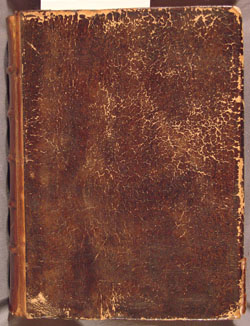
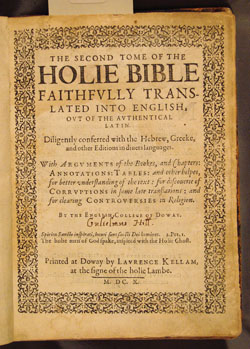 Notes on Psalm 21 in volume two of the Douai Old Testament indicate prophecies of the Church and of the Eucharist. The whole of this Psalm, which Jesus quoted from the Cross, can be viewed by clicking here.
Notes on Psalm 21 in volume two of the Douai Old Testament indicate prophecies of the Church and of the Eucharist. The whole of this Psalm, which Jesus quoted from the Cross, can be viewed by clicking here.
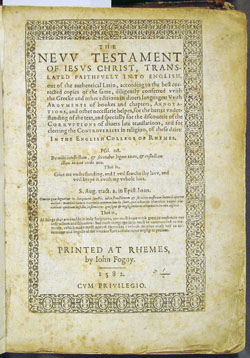
The New Testament of Jesus Christ, translated faithfully into English, out of the authentical Latin, according to the best corrected copies of the same, diligently conferred with the Greeke and other editions in divers languages; with Arguments of bookes and chapters, Annotations, and other necessarie helpes, for the better understanding of the text, and specially for the discoverie of the Corruptions of divers late translations, and for cleering the Controversies in religion, of these daies. Printed at Rhemes [Rheims, France]: by John Fogny, 1582. (SPEC COLL BS180.1582)
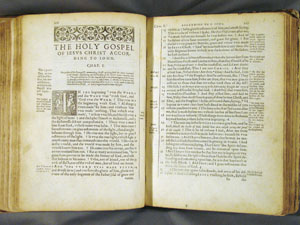 The Gospel of John begins with an ornate headpiece and an illustrated initial (on page 236). A phrase in John's first chapter is an important assertion of the Incarnation and was therefore given emphasis typographically: "The Word was made flesh" is set off from the rest of the text by being entirely in capital letters and given kerning, extra space inserted between the letters. See the lefthand page, three lines up from the bottom.
The Gospel of John begins with an ornate headpiece and an illustrated initial (on page 236). A phrase in John's first chapter is an important assertion of the Incarnation and was therefore given emphasis typographically: "The Word was made flesh" is set off from the rest of the text by being entirely in capital letters and given kerning, extra space inserted between the letters. See the lefthand page, three lines up from the bottom.
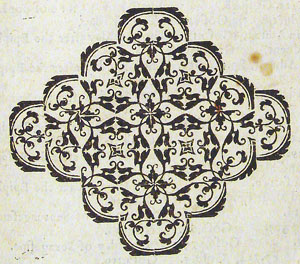 At the end of the last book of the Bible, Apocalypse (the Greek word for "Revelation"), the tailpiece is an elaborate decoration which has the cross as its heart. The care it takes to find the cross within this design is a metaphor for the process of ruminating about the word of God in order to perceive the truth.
At the end of the last book of the Bible, Apocalypse (the Greek word for "Revelation"), the tailpiece is an elaborate decoration which has the cross as its heart. The care it takes to find the cross within this design is a metaphor for the process of ruminating about the word of God in order to perceive the truth.
 Uniquely, Gonzaga University's copy of Luther's works has autograph biblical commentaries added to it by two colleagues of Martin Luther: Philipp Melanchthon and Paul Eber.
Uniquely, Gonzaga University's copy of Luther's works has autograph biblical commentaries added to it by two colleagues of Martin Luther: Philipp Melanchthon and Paul Eber.
This complete edition of Luther's works in Latin was published just ten years after his death. Rev. Francis Joseph McGarrigle, S.J., acquired the Opera omnia ca. 1930 in Northern Europe, probably Belgium, on behalf of the Oregon Province. The edition was at the Jesuit scholasticate at Mount St. Michael's outside Spokane.
The title page of each volume has an illustrated border showing the emblems of the four evangelists in roundels; the Duke of Saxony and Luther are depicted kneeling before the crucified Christ. The name ABRAHAM BRAYN is handwritten above the publication information here.
Tomus primus [-quartus et idem ultimus] omnium operum: Reverendi Patris D.M.L. quae vir Dei ab Anno XVII. usque ad Anni vicesimi aliquam partem, scripsit et edidit, quorum catalogum in fine Tomi invenies. 4 volumes. Ienae Excudebat Christianus Rhodius, 1556-1558 (SPEC COLL BR330. A2 1556 v. 1-4)
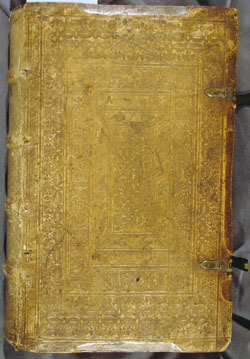

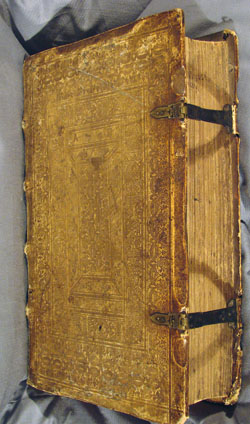
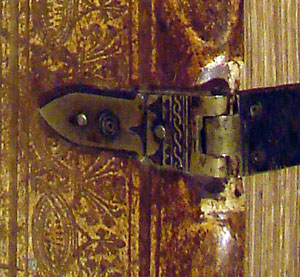 Toolwork on the covers of these volumes and the presence of clasps to protect the large books show that the text was highly valued.
Toolwork on the covers of these volumes and the presence of clasps to protect the large books show that the text was highly valued.
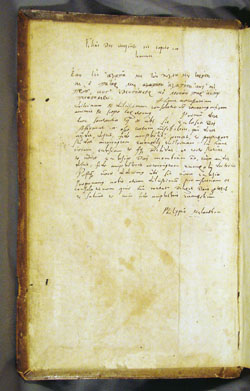
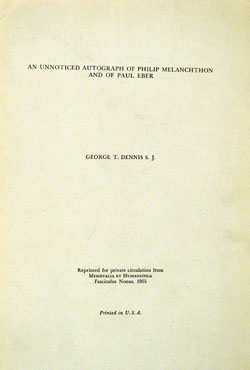
Philipp Melanchthon, Luther's close friend and colleague, personally handwrote his commentary on John 14:24 on a flyleaf of volume two. Melanchthon quoted the scripture in Greek and commented in Latin, signing it at the end. On the facing page Paul Eber, friend of both Luther and Melanchthon, likewise handwrote his commentary on 1 Corinthians 28-31, in Greek and Latin, signing and dating his work.
In the noted scholarly periodical Mediaevalia et Humanistica George T. Dennis, S.J., published the discovery of Melancthon's and Eber's autograph commentaries in Gonzaga's edition of Luther. Dennis recorded the history of Fr. McGarrigle's purchase of the Opera omnia.

The Gonzaga Collection also owns volume five from the first Jena edition of Luther's works in German. The Jena edition was instigated by Johann Friedrich I, Duke of Saxony and was published in 1555-1558.
Der fünffte Teil aller Bücher und Schrifften des thewen seligen Mans Doct. Mart. Lutheri: vom XXX. jar am bis auffs XXXIII. Gedruckt zu Jhena: Durch Christian Rödingers Erben, 1557. (SPEC COLL BR330.A2 1555)
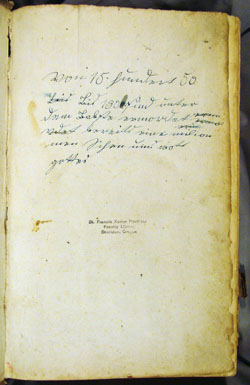 Volume five from the original Jena edition was in the Faculty Library of the St. Francis Xavier Novitiate in Sheridan, Oregon, as attested by its book stamp. The full page with the book stamp is shown to the right; below is an enlargement of the stamp.
Volume five from the original Jena edition was in the Faculty Library of the St. Francis Xavier Novitiate in Sheridan, Oregon, as attested by its book stamp. The full page with the book stamp is shown to the right; below is an enlargement of the stamp.
 Only The Gonzaga Collection owns the 1518 edition of St. Thomas Aquinas' commentary on Aristotle's De Anima, and likewise unique are two seventeenth-century manuscripts with commentaries on Aristotle's Physics, at least one by a Jesuit.
Only The Gonzaga Collection owns the 1518 edition of St. Thomas Aquinas' commentary on Aristotle's De Anima, and likewise unique are two seventeenth-century manuscripts with commentaries on Aristotle's Physics, at least one by a Jesuit.
Like the 1521 Dominican Missal, this is a unicum, the unique existing copy of this edition. At the end of the text is the colophon (from the Greek for "finishing stroke"), a feature carried over from medieval manuscripts. Here the printer put the information now found on title pages: author, title of work, publisher and place of publication, and date printed. Often, as here, a printer also included an emblem representing his press: the L and A in the emblem here are the initials of Luc Antonio Giunta.
Thomas Aquinas, Saint. In libros de Anima Aristoteles expositio. Venice: Lucantonio Giunta, 1518 (Inv. T31)
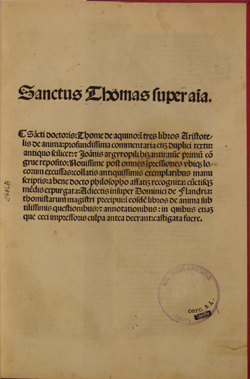 Early books used the abbreviations found in medieval manuscripts, and an example of this is in the top line of the title page: the mark above the "i" in the last word was often used to show that a nasal letter (an "n" or "m") was omitted. Here both were left out from the word anima, "soul." This first page also indicates that the volume contains a second work, the commentary on De anima by Dominic of Flanders, O.P. (found on folios 64-86). Professor Linda Carroll, who has studied this volume at Gonzaga, suggests it may have been printed for student use, for the University of Padua had reopened in 1517 and Dominic of Flanders was a Dominican theology professor. The overstruck book stamp shows that the book was owned by the Jesuits when the whole western part of the country was one province, the California Province. When the Oregon Province was created, the word "CALIF" was cancelled and "OREG. S.J." was added to update the information.
Early books used the abbreviations found in medieval manuscripts, and an example of this is in the top line of the title page: the mark above the "i" in the last word was often used to show that a nasal letter (an "n" or "m") was omitted. Here both were left out from the word anima, "soul." This first page also indicates that the volume contains a second work, the commentary on De anima by Dominic of Flanders, O.P. (found on folios 64-86). Professor Linda Carroll, who has studied this volume at Gonzaga, suggests it may have been printed for student use, for the University of Padua had reopened in 1517 and Dominic of Flanders was a Dominican theology professor. The overstruck book stamp shows that the book was owned by the Jesuits when the whole western part of the country was one province, the California Province. When the Oregon Province was created, the word "CALIF" was cancelled and "OREG. S.J." was added to update the information.
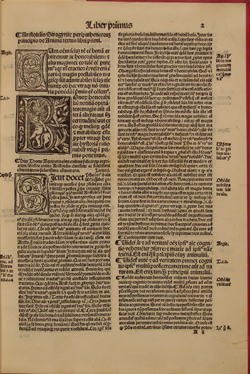 The book has 102 woodcut initials, three shown to the left on folio 2. Most have vegetal decoration, some have vignettes. Sixteenth-century notes were handwritten in the margins, as on fols. 23v and 38. The volume was rebound ca. 1965.
The book has 102 woodcut initials, three shown to the left on folio 2. Most have vegetal decoration, some have vignettes. Sixteenth-century notes were handwritten in the margins, as on fols. 23v and 38. The volume was rebound ca. 1965.
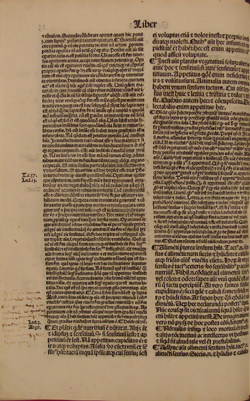
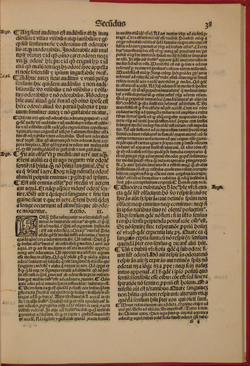
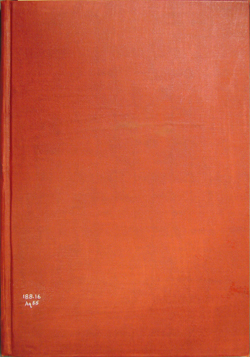
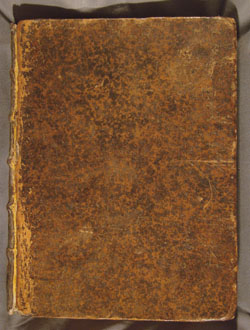
These two volumes not only record otherwise unknown texts: They also give a glimpse into late-seventeenth-century book making. These two volumes are handwritten on what may be called "template books": bound, blank books, with engraved frames provided for the title pages, marbling, and, in one case, an engraved frontispiece. Stationers would evidently sell these blank "template books" for students to record course notes and for scholars to compose books. The Gonzaga Collection holds, in these two volumes, two unique texts and also unique examples of two different "template books."
The earlier volume is a reportatio, a faithful "reporting" or transcription of a series of lectures. The student John Middleton transcribed the lectures of Pierre Grenier.
Commentarii in phisicam Ar[istote]lis, authore sapientissimo magistro nostro Petras Grenier, auditore Joanne Middleton. Parisiis, In Aula maiore Lexovea, Anno Domini 1670 (Inv. G65)
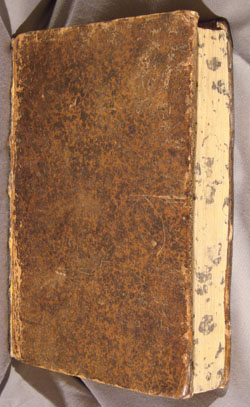

 The engraved frontispiece consists of a bust portrait of Aristotle and his biography in French. The printer had also engraved the elaborate architectural surround for the title page, where John Middleton wrote the title and other information by hand. He identifies his teacher, Petras Grenier, as "most wise" (sapientissimo) and calls him the author. John identifies himself as "hearer" (auditore).
The engraved frontispiece consists of a bust portrait of Aristotle and his biography in French. The printer had also engraved the elaborate architectural surround for the title page, where John Middleton wrote the title and other information by hand. He identifies his teacher, Petras Grenier, as "most wise" (sapientissimo) and calls him the author. John identifies himself as "hearer" (auditore).
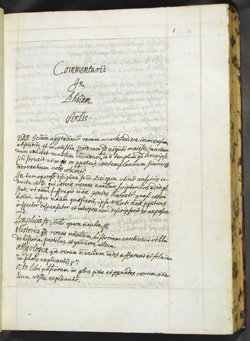
A characteristic of medieval and early modern manuscripts was the abbreviation of words, especially words used frequently. Throughout this volume the name of Aristotle is highly abbreviated: On the title page and on the first page of the text the name appears simply as "Ar" and then the genitive singular ending "lis" with a stroke through the "l" to indicate that the word is abbreviated. The word "phisicam" is also abbreviated.
Below are shown the final two pages of the text. On page 581, Middleton wrote the colophon to mark the completion of his work: "Soli Deo Honor et Gloria / Finis / Undecimo diei Maii / Anno Domini / 1670 / Joannes Middleton" (To God alone be honor and Glory. The end. On the eleventh day of May in the year of the Lord 1670, John Middleton").
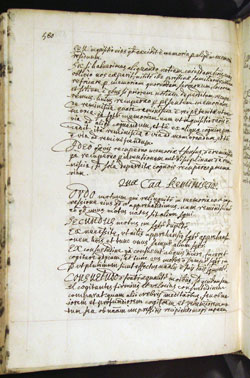
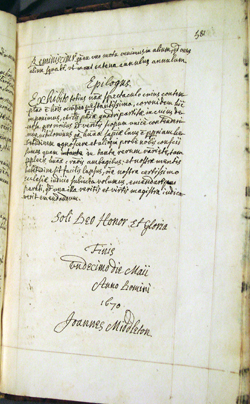
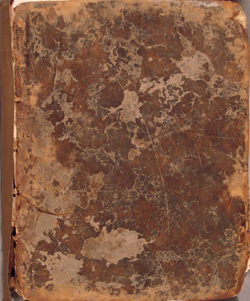
The second template book in The Gonzaga Collection is the work of a Jesuit scholar, apparently Jean Baptiste de Fourmestraulx.
Jean Baptiste de Fourmestraulx(?), Liber summus phisicorum. Anno 1693. Title as given on first page of text: Commentarius in octo libros Ar[istote]lis, Prœmium. De Na[tur]a octo et divisione Phisica." (Inv. zz011).
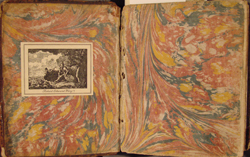 Colorful marbling is on the endpapers.
Colorful marbling is on the endpapers.
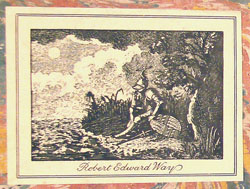 A former owner, Robert Edward Way, placed his book plate in the front of the book and also wrote an inscription on one of the pages.
A former owner, Robert Edward Way, placed his book plate in the front of the book and also wrote an inscription on one of the pages.
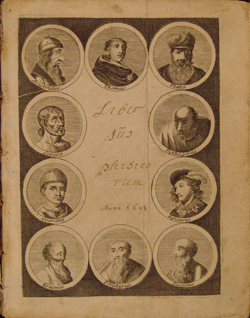
Notably the title page features an engraved border comprised of ten bust portraits with names inscribed. In the top row are "Aristoteles," Thomas [Aquinas], and Plato. This shows how highly St. Thomas was respected as a philosopher. He not only ranks with Plato and Aristotle: he is central.
Along the left side are Seneca and Socrates; on the right are Pythagoras and Epicurus. The bottom row consists of Erasmes[!], Porphyruis[!], and Diogenes.
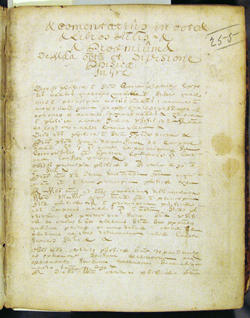
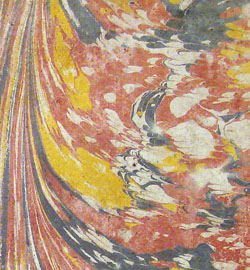
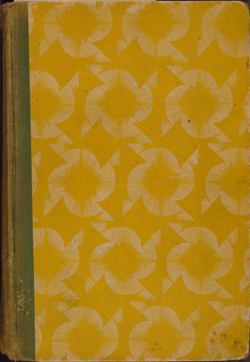 Several first editions of modern literature are within The Gonzaga Collection, including fiction by Nathaniel Hawthorne, Charles Dickens, andSir Arthur Conan Doyle, and poetry by John Greenleaf Whittier and George Meredith. The four first editions displayed here are works by British Catholic satirist Evelyn Waugh (1903-1966).
Several first editions of modern literature are within The Gonzaga Collection, including fiction by Nathaniel Hawthorne, Charles Dickens, andSir Arthur Conan Doyle, and poetry by John Greenleaf Whittier and George Meredith. The four first editions displayed here are works by British Catholic satirist Evelyn Waugh (1903-1966).
A stylized sunburst in yellow and white decorates the cover and endpapers.
Evelyn Waugh, Vile Bodies. New York: J. Cape, H. Smith, 1930. First American edition. (SPEC COLL PR6045.A97 V5)
The book stamp of the Jesuit Scholasticate Library of Spokane is found on the front endpaper.
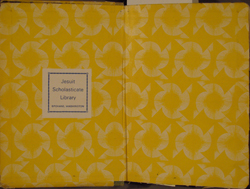

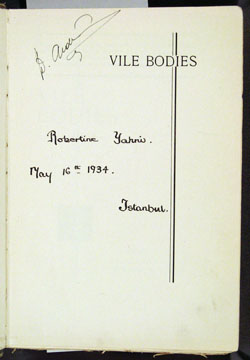 Previous owner inscriptions on the half title page include that of Robertine Yahni, dated May 16th, 1934, in Istanbul. His signature recurs on page 191.
Previous owner inscriptions on the half title page include that of Robertine Yahni, dated May 16th, 1934, in Istanbul. His signature recurs on page 191.
|
The motif on the cover and endpapers is also used for the opening initial of each chapter.
|
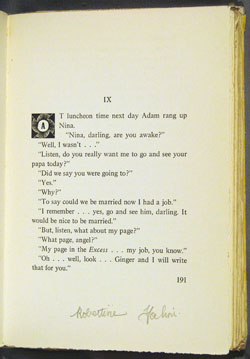 |
|
Waugh's London publisher used red-black marbling and gilt spine titles on many of Waugh's works.
|
In this novel, Waugh satirized the attempts by Haile Selassie, Emperor of Ethiopia, to modernize his country. Waugh may have drawn the map which serves as frontispiece. The same Jesuit bookplate in Vile Bodies is found in this book as well, on page [2] of the cover. Evelyn Waugh, Black Mischief. London: Chapman and Hall, 1932. (SPEC COLL PR6045.A97 B4 1932) |
![marbled front cover, Waugh, MR LOVEDAY'S LITTLE OUTING [1936]](https://s3.amazonaws.com/libapps/customers/310/images/zz036-2.jpg)
The first collection of Waugh's short stories appeared in 1936. The dust jacket and frontispiece share the same design. Tipped into the volume is the calling card of Lady Ribblesdale, 420 Park Avenue, with her autograph note: "Dear Muriel - with love and I do hope this will amuse you for a few moments. Best wishes from Ava." Ava Willing Astor, former wife of John Jacob Astor, married Thomas Lister (Lord Ribblesdale) in 1919.
Evelyn Waugh, Mr. Loveday's Little Outing And Other Sad Stories. [Frontispiece by Thomas Derrick.] London: Chapman and Hall, [1936]. (SPEC COLL PR6045.A97 M5 1936b)
|
|
Evelyn Waugh, Love among the Ruins: a romance of the near future. With decorations by various eminent hands including the author's. London Chapman & Hall, 1953. (SPEC COLL PR6045.A97 L58 1953)
|
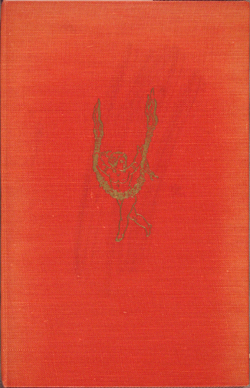 The front dust jacket and half title page share the same illustration. The cover is embossed with a gilt garland and putto. Waugh himself drew "Coalition," as the inscription indicates. He is thought to have created several of the other illustrations by adapting designs made by other artists.
The front dust jacket and half title page share the same illustration. The cover is embossed with a gilt garland and putto. Waugh himself drew "Coalition," as the inscription indicates. He is thought to have created several of the other illustrations by adapting designs made by other artists.
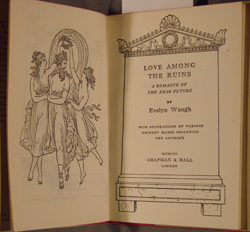

A striking instance of the Jesuit conviction that faith and reason are closely united is in the works in this last section of the exhibition. A major scholarly research tool by E. A. Lowe and an exemplary edition of the ninth-century Book of Armagh were included in the library of the Sheridan novitiate, showing that the faculty were training the students to recognize, value, and potentially to contribute to scholarship. In addition, Professor Lowe's autograph letter to Fr. John Taylor, who was then teaching at Sheridan, is partly in response to Fr. Taylor's own scholarship.

Over 2,000 facsimile samples from 1811 manuscripts written before the ninth century comprise this eleven-volume set. By studying manuscript hands, scholars can identify where and when a manuscript was written and reconstruct the history and transmission of texts. Lowe's estimable tool of humanistic research was owned by St. Francis Xavier Novitiate at Sheridan Oregon. It is made all the more valuable by the presence, inside the back cover, of an autograph letter by the author, who praises several Jesuit scholars by name.
Codices latini antiquiores: A Palaeographical Guide to Latin Manuscripts Prior to the Ninth Century. Ed. E. A. Lowe. 11 vols. and supplements. Oxford: Clarendon Press, 1934-1971. (SPEC COLL Z114.C677 Oversize)
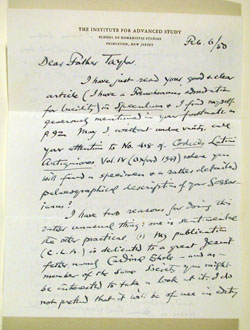
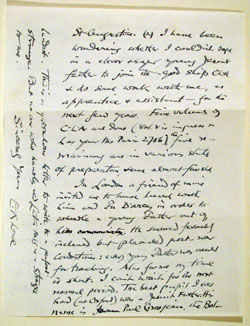
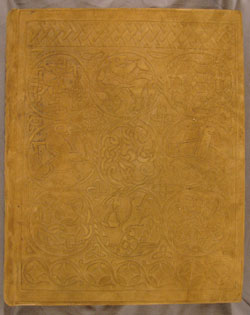 This scholarly edition of the celebrated Book of Armagh (begun 807-08) includes the earliest documents pertaining to St. Patrick. The full contents of the manuscript are the Life of St. Patrick written by Muirchu, a seventh-century monk of Leinster; the New Testament; and the Life of St. Martin of Tours. The manuscript was transcribed and edited by John Gwynn, professor of Divinity at the University of Dublin. Six plates reproduce leaves from the original manuscript, and the original illustrations are reproduced in line drawings.
This scholarly edition of the celebrated Book of Armagh (begun 807-08) includes the earliest documents pertaining to St. Patrick. The full contents of the manuscript are the Life of St. Patrick written by Muirchu, a seventh-century monk of Leinster; the New Testament; and the Life of St. Martin of Tours. The manuscript was transcribed and edited by John Gwynn, professor of Divinity at the University of Dublin. Six plates reproduce leaves from the original manuscript, and the original illustrations are reproduced in line drawings.
 The limited edition of 400 copies was bound by Galwey & Co., Eustace Street, Dublin, in brown suede, the front and spine embossed with Celtic designs.
The limited edition of 400 copies was bound by Galwey & Co., Eustace Street, Dublin, in brown suede, the front and spine embossed with Celtic designs.
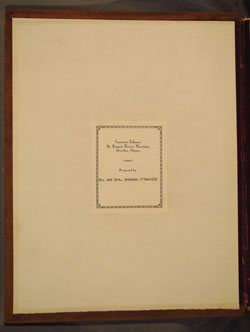 Copy No. 251 is in The Gonzaga Collection. Mr. and Mrs. Brendan O'Farrell donated this beautiful and scholarly volume to the Jesuits at Sheridan, as commemorated by a book plate on page [2] of the cover.
Copy No. 251 is in The Gonzaga Collection. Mr. and Mrs. Brendan O'Farrell donated this beautiful and scholarly volume to the Jesuits at Sheridan, as commemorated by a book plate on page [2] of the cover.
Catherine Brown Tkacz, Ph.D.
Guest Curator
